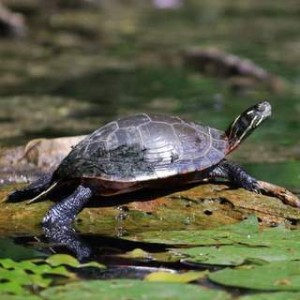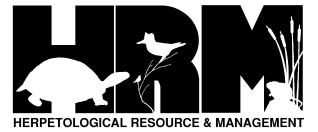Painted Turtle
Overview:
Scientific Name: Chrysemys picta
Size: 3.5 – 9.8” (adult carapace length)
Status: Common to abundant throughout most of the Great Lakes region, though population densities lower in far north.

Habitat:
Quiet or slow-moving permanent waters with soft bottom substrate, abundant aquatic plants, and basking sites (e.g, logs, ricks, or mats of floating vegetation). Will at least temporarily occupy vernal ponds, sterile impoundments, ditches, and faster-moving streams and rivers, and are able to tolerate fairly high levels of organic pollution. Will move over land if needed. Deeper or spring-fed waters often favored in fall and winter, with spring migrations to shallower or productive ponds, marshes, and lake edges.
Adult Coloration:
Black or olive carapace with red bars or blotches on marginal scutes, and often thin red stripe down midline. Plastron is yellow, often tinged with red, pink, or orange, and usually has a dark central blotch or figure that varies according to subspecies (see below). Occasionally entire shell will be stained dark reddish brown from minerals absorbed from water or substrate. Skin is black or olive. Both head and throat have yellow stripes, sometimes with yellow streak or bar behind eye. Eye is yellow with dark horizontal bar through pupil. Upper neck, legs, and tail are striped with red and/or yellow.
Adult Characteristics:
Smooth, unkeeled carapace. Rear marginals unserrated. Upper jaw with two toothlike cusps on either side of terminal notch. Males generally smaller and flatter than females and greatly elongated front claws.
Juvenile Characteristics:
Rounded, slightly keeled carapace that averages 1” in length. Coloration like adult’s but brighter and more contrasting.
Species Confused With:
Map Turtles lack red markings and have a keeled carapace with a serrated rear margin. Red-eared Sliders have a broad reddish band or stripe behind each eye, lack red carapace markings, and has a yellow plastron, usually with a single black spot in each scute.
Distinction between subspecies:
Four distinct subspecies are recognized, two of which are found in the Great Lakes basin. The Midland Painted Turtle (C. picta marginata) tends to have prominent red stripes on forelegs and neck, and plastron is usually yellow or orangish yellow with elongate dark central blotch that does not cover more than half the plastral width. The Western Painted Turtle (C. picta belli) usually has narrow yellow stripes on forelegs and neck, and a pattern of light lines on the carapace. Plastron may be reddish or orangish, with complex central pattern of dark and light lines that extends out along the scute seams and often covers more than half of the plastral width. Intergrade individuals within the overlapping range display a variable blending of these characteristics.
References:
- Amphibians and Reptiles of the Great Lakes Region by Jim Harding
- Harding, J.H. and J.A. Holman. 1990. Michigan Turtles and Lizards. MSU Cooperative Extension Service and MSU Museum. 96 pp.
- Ruthven, A. G., H. B. T. Gaige, et al. 1912. The herpetology of Michigan, by Alexander B. Ruthven. Crystal Thompson and Helen Thompson; Memoranda towards a bibliography of the archaeology of Michigan, by Harlan I. Smith; prepared under the direction of Alexander G. Ruthven. Lansing, Mich., Wynkoop Hallenbeck Crawford, State Printers.
- Holman, J. A. 2012. The Amphibians and Reptiles of Michigan: A Quaternary and Recent Faunal Adventure. Detroit, Mich., Wayne State University Press.
- Conant, R., and Collins, J. T. 1998. Reptiles and Amphibians: Eastern, Central North America. Houghton Mifflin Harcourt Press.
Credits:
- Jim Harding
